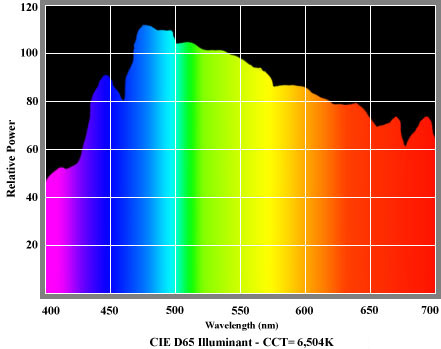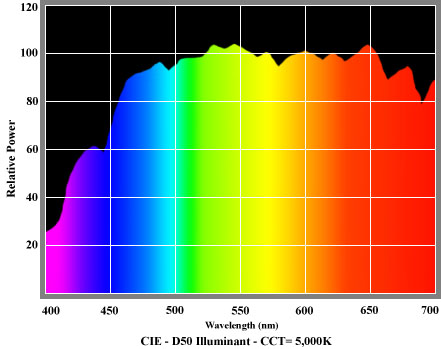 A standard illuminant is represented by a profile, or graph, of the energy produced by a source of light across the wavelengths of the visible spectrum - a well-defined spectral power distribution. Various standard illuminants are published by the CIE to provide a means of comparing colours or images under different lighting conditions.
A standard illuminant is represented by a profile, or graph, of the energy produced by a source of light across the wavelengths of the visible spectrum - a well-defined spectral power distribution. Various standard illuminants are published by the CIE to provide a means of comparing colours or images under different lighting conditions.
Standard illuminants represent precise colours because they define a particular spectral distribution and therefore cannot be misinterpreted. Colour temperature describes the colour of light emitted by a perfect black-body radiator, a theoretical object which natural sources cannot emulate. Two different materials used for light souces can produce the same colour temperature but the spectral distributions of their outputs may differ, particularly in green and magenta regions. It is consequently inappropriate to use colour temperature as the measure of a standard illuminant, so correlated colour temperature (CCT) is used instead. This provides an unambiguous description of colour.
Two commonly used standard illuminants are D65, shown above, which is regarded as representing neutral cool daylight, and D50, shown below and to the right, which is regarded as the equivalent of normal warm daylight. The D65 illuminant is used in industrial colorimetric applications where colours of products must be precisely controlled, and the D50 illuminant is generally the preferred choice in graphic art applications. D65 and D50 are specific colours that fall on the CIE chromaticity diagram. They are not ranges of colours. D50 has a correlated colour temperature of 5,000K and D65 has a correlated colour temperature of 6,504K.
In summary, the D50 and D65 standard illuminants therefore represent precisely defined "white" light sources. D50 is broadly equivalent to standard sunlight without the contribution of blue light from a clear sky. D65 equivalents are more difficult to find in the real world, although a very similar spectral distribution might be found on a clear day at very high altitudes.






